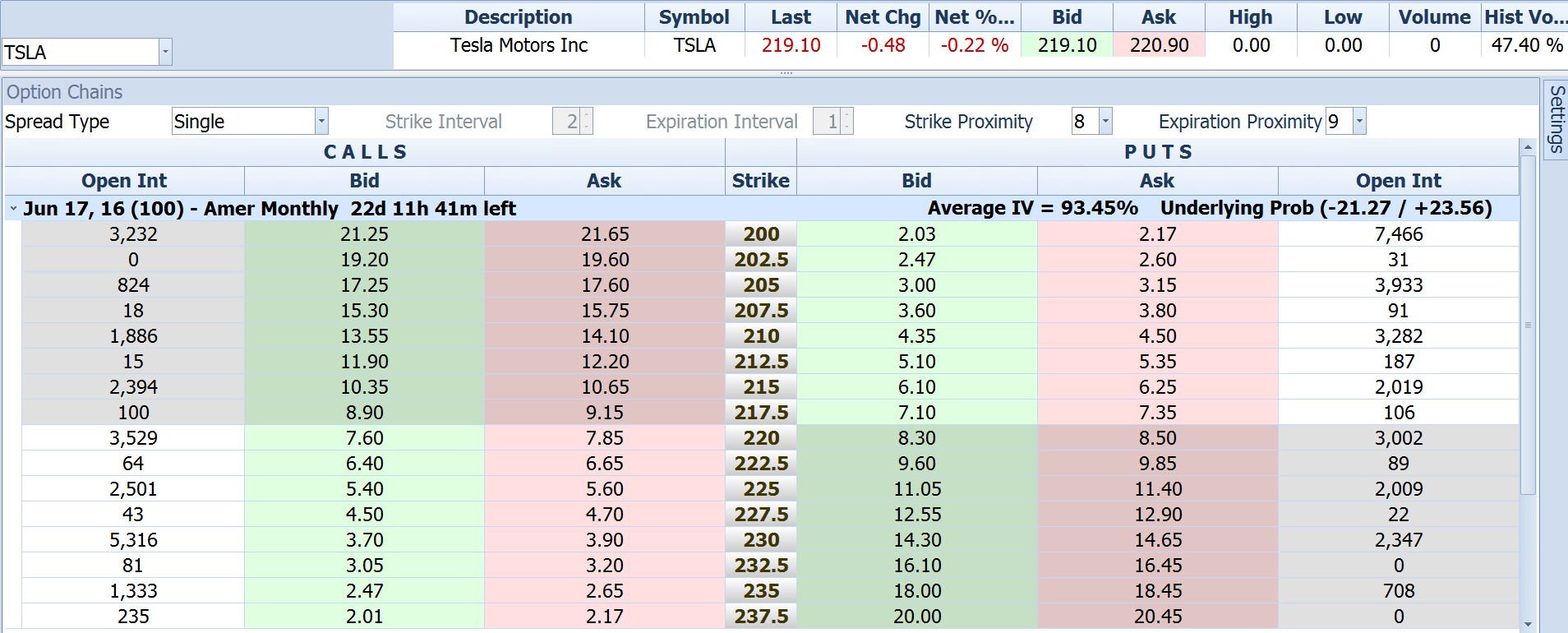Put and call options provide ways to speculate on the price of a stock or exchange-traded fund at low cost. Alternatively, they can be used as insurance to protect a stock or ETF position in case of a down market. An interesting fact about options is that the number of them that are in existence changes from time to time. There are always exactly as many options as are needed, no more and no less. They come into existence when they are needed, and they disappear when no longer required.
Here’s how that works. Below is the option chain, or list of available options for the stock of Tesla Motors. Note that the column labeled Open Interest for the calls at the $220 strike reads 3529. For each of those 3529 contracts, someone has purchased the right to buy 100 shares of Tesla stock at $220.

Suppose that we now decide that we want to buy one of those options. We can see in the option chain that the Ask price for the $220 calls is $7.85 per share.
If we decide to buy one, will we be buying one of those 3529 contracts that currently exist (the current Open Interest)? If so, from whom? And if not, then where will our contract come from?
First of all, as to whether we will be buying one of the existing calls, the answer is – maybe. For there to be an Ask price for the option, someone has to be offering to sell them at that price. It may be that that person bought the option at some time in the past. We would then say that he is currently long the option – he owns it and is looking to sell it and close out his trade. In that case we would indeed be buying one of those 3529 calls already in existence. If so, then after our transaction the total Open Interest will remain the same at 3529 contracts. One of the existing contracts will simply have been transferred from its former owner to us.
But, it also could be the case that the call being offered at $7.85 may not exist yet. Put and call options may be offered for sale by people who don’t own them. This is a perfectly legitimate and above-board offer. When someone sells a call option that they do not own, we say that they are short the call option. In that case they are accepting payment for the call now, and they are accepting an obligation in return. That obligation, in this case, would be to turn over 100 shares of the Tesla stock to us, whenever we should ask for it, in exchange for another $220 per share to be paid at that time. The reason for someone to sell a call short is that they do not believe that the stock will go up and therefore the call owner will not exercise the option. If the call seller is right about that, then the money collected for selling the call will be pure profit to them.
That short seller of the call may or may not also own the TSLA stock now. If he did, then he could simply deliver that stock to us if and when we exercised the call option. But if he doesn’t already have the stock, then when we exercise the option he will have to buy the shares in the open market at that time in order to deliver them to us at the $220 agreed-on price. If at that time he has to pay more for the shares than the $220 that he will be receiving from us, that is his problem. Our gain will be his loss.
The possibility of having to deliver the stock and accept payment of exactly $220 per share no matter what the actual value of the stock might be at that time is what the call seller agreed to when he sold the call. That obligation is something real, even though it did not previously exist.
To return to our question as to whether we are buying an existing option or a newly-created one: it depends on what the person who sold it to us is doing. If he is selling a call that he did not previously own, then a new option has been created and the total number of options in the world (the open interest) will increase by one, from 5239 to 5240. But if, instead, that call seller is selling an option that he already owned, having bought it at some time in the past, then it’s just a transfer and the open interest will remain at 5239.
So, now we can see that sometimes an option changing hands results in an increase in open interest and at other times results in no change.
There is one further possibility – that the transaction results in the destruction of an existing contract which will then cease to exist. This will result in a drop in the open interest, from 5239 to 5238. Here is how that might happen.
Let’s say that we do buy the option today from someone who already owns it, so that the open interest remains at 5239 contracts. Then, in a couple of weeks Tesla’s stock has moved up as far as we think it’s likely to go in this run. Our call option will also have gone up in value and we can sell it at a profit, maybe for $10.00 per share. We enter our order to sell to close our option position.
The person to whom we’re selling our call at that time might be buying to close out a short option position that he had. In that case, if both the option seller (us) and the option buyer are closing out their option positions, then one less option is needed and it disappears. The call seller’s obligation to deliver the shares is cancelled when we give up our right to buy them.
In this way options are destroyed when no longer needed, or created when new ones are needed so that there are always as many options as there needs to be.
This is a good thing. It means that we can buy or sell options whenever we want to and choose to be long or short the options, whichever suits us better at the time.
When would we choose to be long options and when would we short them? That is a discussion for future articles. For now, it’s important just to know that we can always choose to do either and never have to worry about whether there are enough options to go around.
This content is intended to provide educational information only. This information should not be construed as individual or customized legal, tax, financial or investment services. As each individual's situation is unique, a qualified professional should be consulted before making legal, tax, financial and investment decisions. The educational information provided in this article does not comprise any course or a part of any course that may be used as an educational credit for any certification purpose and will not prepare any User to be accredited for any licenses in any industry and will not prepare any User to get a job. Reproduced by permission from OTAcademy.com click here for Terms of Use: https://www.otacademy.com/about/terms
Editors’ Picks

USD/JPY dips as bearish pressure persists despite ETF growth
Ripple is finding footing above $1.90 at the time of writing on Tuesday after a bearish wave swept across the broader cryptocurrency market, building on persistent negative sentiment.

EUR/USD climbs toward 1.1800 on broad USD weakness
EUR/USD gathers bullish momentum and advances toward 1.1800 in the second half of the day on Tuesday. The US Dollar weakens and helps the pair stretch higher after the employment report showed that Nonfarm Payrolls declined by 105,000 in October before rising by 64,000 in November.

Gold extends its consolidative phase around $4,300
Gold trades in positive above $4,300 after spending the first half of the day under bearish pressure. XAU/USD capitalizes on renewed USD weakness after the jobs report showed that the Unemployment Rate climbed to 4.6% in November and the PMI data revealed a loss of growth momentum in the private sector in December.

XRP dips as bearish pressure persists despite ETF growth
Ripple is finding footing above $1.90 at the time of writing on Tuesday after a bearish wave swept across the broader cryptocurrency market, building on persistent negative sentiment.

Ukraine-Russia in the spotlight once again
Since the start of the week, gold’s price has moved lower, but has yet to erase the gains made last week. In today’s report we intend to focus on the newest round of peace talks between Russia and Ukraine, whilst noting the release of the US Employment data later on day and end our report with an update in regards to the tensions brewing in Venezuela.
RECOMMENDED LESSONS
Making money in forex is easy if you know how the bankers trade!
I’m often mystified in my educational forex articles why so many traders struggle to make consistent money out of forex trading. The answer has more to do with what they don’t know than what they do know. After working in investment banks for 20 years many of which were as a Chief trader its second knowledge how to extract cash out of the market.
5 Forex News Events You Need To Know
In the fast moving world of currency markets where huge moves can seemingly come from nowhere, it is extremely important for new traders to learn about the various economic indicators and forex news events and releases that shape the markets. Indeed, quickly getting a handle on which data to look out for, what it means, and how to trade it can see new traders quickly become far more profitable and sets up the road to long term success.
Top 10 Chart Patterns Every Trader Should Know
Chart patterns are one of the most effective trading tools for a trader. They are pure price-action, and form on the basis of underlying buying and selling pressure. Chart patterns have a proven track-record, and traders use them to identify continuation or reversal signals, to open positions and identify price targets.
7 Ways to Avoid Forex Scams
The forex industry is recently seeing more and more scams. Here are 7 ways to avoid losing your money in such scams: Forex scams are becoming frequent. Michael Greenberg reports on luxurious expenses, including a submarine bought from the money taken from forex traders. Here’s another report of a forex fraud. So, how can we avoid falling in such forex scams?
What Are the 10 Fatal Mistakes Traders Make
Trading is exciting. Trading is hard. Trading is extremely hard. Some say that it takes more than 10,000 hours to master. Others believe that trading is the way to quick riches. They might be both wrong. What is important to know that no matter how experienced you are, mistakes will be part of the trading process.
The challenge: Timing the market and trader psychology
Successful trading often comes down to timing – entering and exiting trades at the right moments. Yet timing the market is notoriously difficult, largely because human psychology can derail even the best plans. Two powerful emotions in particular – fear and greed – tend to drive trading decisions off course.
